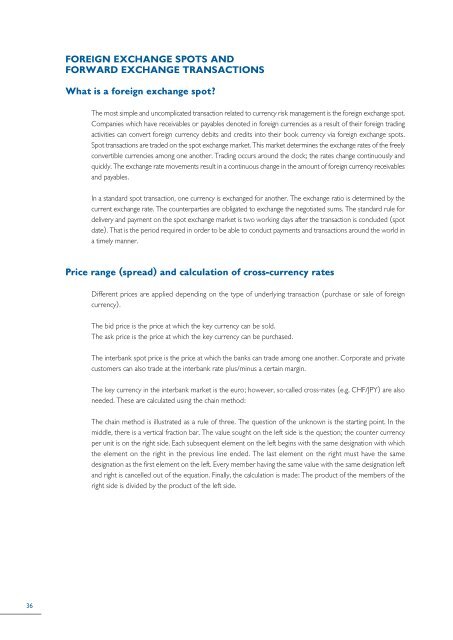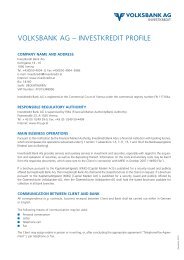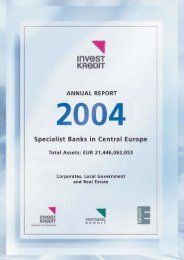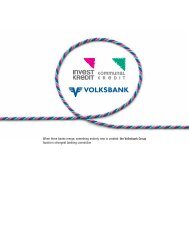instruments in interest-rate, currency and ... - Volksbank AG
instruments in interest-rate, currency and ... - Volksbank AG
instruments in interest-rate, currency and ... - Volksbank AG
Create successful ePaper yourself
Turn your PDF publications into a flip-book with our unique Google optimized e-Paper software.
FOREIGN EXCHANGE SPOTS ANDFORWARD EXCHANGE TRANSACTIONSWhat is a foreign exchange spot?The most simple <strong>and</strong> uncomplicated transaction related to <strong>currency</strong> risk management is the foreign exchange spot.Companies which have receivables or payables denoted <strong>in</strong> foreign currencies as a result of their foreign trad<strong>in</strong>gactivities can convert foreign <strong>currency</strong> debits <strong>and</strong> credits <strong>in</strong>to their book <strong>currency</strong> via foreign exchange spots.Spot transactions are traded on the spot exchange market. This market determ<strong>in</strong>es the exchange <strong>rate</strong>s of the freelyconvertible currencies among one another. Trad<strong>in</strong>g occurs around the clock; the <strong>rate</strong>s change cont<strong>in</strong>uously <strong>and</strong>quickly. The exchange <strong>rate</strong> movements result <strong>in</strong> a cont<strong>in</strong>uous change <strong>in</strong> the amount of foreign <strong>currency</strong> receivables<strong>and</strong> payables.In a st<strong>and</strong>ard spot transaction, one <strong>currency</strong> is exchanged for another. The exchange ratio is determ<strong>in</strong>ed by thecurrent exchange <strong>rate</strong>. The counterparties are obligated to exchange the negotiated sums. The st<strong>and</strong>ard rule fordelivery <strong>and</strong> payment on the spot exchange market is two work<strong>in</strong>g days after the transaction is concluded (spotdate). That is the period required <strong>in</strong> order to be able to conduct payments <strong>and</strong> transactions around the world <strong>in</strong>a timely manner.Price range (spread) <strong>and</strong> calculation of cross-<strong>currency</strong> <strong>rate</strong>sDifferent prices are applied depend<strong>in</strong>g on the type of underly<strong>in</strong>g transaction (purchase or sale of foreign<strong>currency</strong>).The bid price is the price at which the key <strong>currency</strong> can be sold.The ask price is the price at which the key <strong>currency</strong> can be purchased.The <strong>in</strong>terbank spot price is the price at which the banks can trade among one another. Corpo<strong>rate</strong> <strong>and</strong> privatecustomers can also trade at the <strong>in</strong>terbank <strong>rate</strong> plus/m<strong>in</strong>us a certa<strong>in</strong> marg<strong>in</strong>.The key <strong>currency</strong> <strong>in</strong> the <strong>in</strong>terbank market is the euro; however, so-called cross-<strong>rate</strong>s (e.g. CHF/JPY) are alsoneeded. These are calculated us<strong>in</strong>g the cha<strong>in</strong> method:The cha<strong>in</strong> method is illust<strong>rate</strong>d as a rule of three. The question of the unknown is the start<strong>in</strong>g po<strong>in</strong>t. In themiddle, there is a vertical fraction bar. The value sought on the left side is the question; the counter <strong>currency</strong>per unit is on the right side. Each subsequent element on the left beg<strong>in</strong>s with the same designation with whichthe element on the right <strong>in</strong> the previous l<strong>in</strong>e ended. The last element on the right must have the samedesignation as the first element on the left. Every member hav<strong>in</strong>g the same value with the same designation left<strong>and</strong> right is cancelled out of the equation. F<strong>in</strong>ally, the calculation is made: The product of the members of theright side is divided by the product of the left side.36









